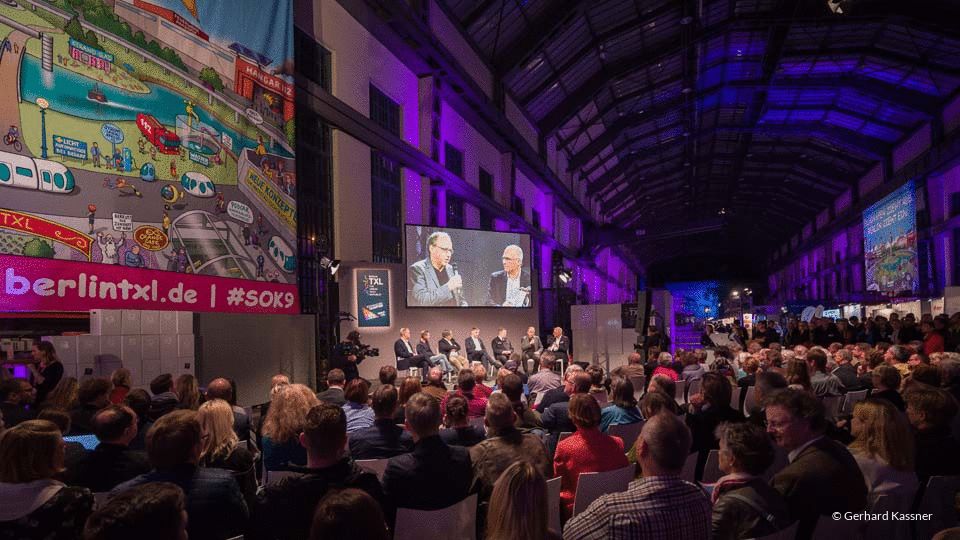More than 700 visitors came to the 9th public site conference on 6 November 2018 to find out about the plans for the subsequent use of Tegel Airport.
The setting is impressive: with a length of over 180m and a floor area of over 5,500 square metres, the Peter Behrens Hall is an architectural landmark of Berlin’s industrial history. But where students and researchers from the Technical University of Berlin usually test concrete steles and other building materials, this late summer November evening is not about looking back – quite the opposite. At the 9th public location conference, the future of Berlin is being discussed. It’s about smart living, technology for the cities of tomorrow and what opportunity the metropolis of Berlin will have when Tegel Airport closes in 2021. Or as Philipp Bouteiller, managing director of Tegel Projekt GmbH, put it at the opening: “Berlin TXL will be a future-oriented high-tech location – not only for Berlin, but for cities worldwide.”
Anticipation and impatience
For the ninth time already, Tegel Projekt GmbH invites you to the site conference (find out more about the format here) to inform about the post-use projects together with a large number of partners. They are all united by anticipation, but also impatience. The Beuth University of Applied Sciences, which will move into the Urban Tech Republic industrial and research park, urgently needs the space on the new campus. Its “Life Sciences and Technology” department will move in there. Professor Hans Gerber, 1st Vice-President of Beuth University of Applied Sciences, underlines in the panel “Technologies for the City of the Future” why the location is such a good fit from his point of view: “The combination of indoor and outdoor space is perfect in Tegel, because we don’t just work and research in covered rooms, we also need large outdoor areas for our experiments.”
The Beuth University of Applied Sciences is one of the anchor users of the Urban Tech Republic and will in future form the scientific core in the industrial and research park. The impetus for the development of urban technologies will come from there, which will then be tested in the surrounding areas and transformed into business models. The second anchor user also has an urban focus. The Berlin Fire Brigade is planning to move its Fire and Rescue Academy into the airport hangars in Tegel. With the improved training opportunities, the fire brigade will contribute to “providing Berlin with a safe everyday life, even as the city grows,” explains Dr Karsten Homrighausen, the new state fire director. For the Berlin fire brigade, however, it is also about the use of new technologies, be it electric mobility for the vehicle fleet or new communication technology for the alarm chains.
What will the mobility of tomorrow look like?
The panellists – moderated by Volker Wieprecht – discuss all these topics in a lively exchange with the visitors. Many of them take the opportunity to ask questions and comment on the plans. The topic of mobility, which focuses on autonomous driving in addition to electromobility, attracted a particularly high level of interest. Under the direction of Professor Sahin Albayrak, the TU Berlin is operating a test track for unmanned vehicles on the Straße des 17. Albayrak comments on Berlin’s pioneering role with a wink: “If a car is intelligent enough to find its way around Ernst-Reuter-Platz, it will be able to do so all over the world.
Big Picture meets development plan
Visitors to the Peter Behrens Hall can find out about the concrete plans of the individual users and the big picture of subsequent use behind them in very different ways. The information stands of the partners are lined up on an elongated market square area and offer the opportunity to exchange information about the plans. Integrated into the market square, an exhibition over 20 metres long shows in detail which new solutions for energy and transport are to be implemented in the new city quarter – and how far the development plans behind them are already. The energy concept for the new location in particular has a forward-looking character. Andreas Irmer, Managing Director of Stadtwerke Berlin, together with his partner E.ON, is relying on a so-called LowEx network (find out more about the energy concept here), which will ensure that the energy supply in Berlin TXL “not only functions more sustainably, but also more cheaply than today’s neighbourhood solutions”.
Schumacher Quarter has a model character
Explanations of the policy plans are also available at first hand at the site conference: using the exhibition posters and surrounded by a crowd of people, Senate Building Director Regula Lüscher explains to visitors how the Senate Department is trying to make the new Schumacher Quarter, with at least 5,000 flats, as diverse as possible: “Of course, as an administration we also have to specify things. But we try to build the hardware in such a way that it allows as much flexibility as possible.” Katrin Lompscher, Senator for Urban Development and Housing, formulates the substantive demand on the new residential quarter on the panel “New Housing for Berlin in the Schumacher Quarter”: “The Schumacher Quarter is a clear model quarter for Berlin: it should meet high qualitative standards, i.e. we want to observe very many intelligent, climate-friendly and new elements.” Maren Kern from the Association of Berlin-Brandenburg Housing Companies hopes that the model character of the Schumacher Quartier will help change the minds of citizens who are generally critical of new housing construction.
What all the speeches at the location conference have in common is that the global growth of cities requires new solutions for urban life, living and working. Philipp Bouteiller sees this as the great opportunity for the new location: “Berlin TXL with the Urban Tech Republic, the Schumacher Quarter and the Landscape Space is Berlin’s answer to one of the great challenges of our time.”
